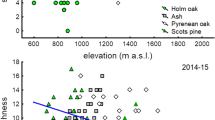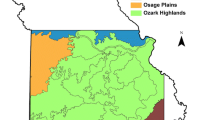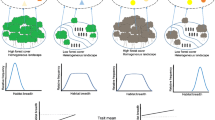Abstract
Montane regions support distinct animal and plant communities that are widely viewed as communities of high conservation concern due to their significant contribution to regional biodiversity. These communities are also thought to be particularly vulnerable to anthropogenically caused stressors such as climate change, which is generally expected to cause upward shifts and potential range restrictions in montane plant and animal distributions. In the northern Appalachian Mountains of North America, not only is it becoming warmer at mid-elevations but the ecotone between the northern hardwood and the montane coniferous forests is also shifting. Therefore, species that are limited by climate or habitat along the elevational gradient of mountains may also be experiencing distributional shifts. We studied birds along replicate elevational gradients in the White Mountains of New Hampshire, USA, from 1993 to 2009 and used mixed effects models to estimate the rate of elevational change to test the hypothesis that northern hardwood forest- and montane forest-dependent birds are shifting upslope, consistent with climate change predictions. As predicted, the upper elevational boundary of 9 out of 16 low-elevation species showed evidence of shifting upslope an average of 99 m over the course of the study period. Contrary to our expectations, 9 out of 11 high-elevation species had lower elevational boundaries that shifted downslope an average of 19 m. The opposing elevational shifts of two distinct and adjacent bird communities is, to our knowledge, unprecedented and highlights the need for caution when applying conventional expectations to species’ responses to climate change.
Zusammenfassung
Trotz aktueller Erwärmung verlagern Gebirgsvögel in den nördlichen Appalachen ihr Vorkommen hangabwärts
Bergregionen beherbergen besondere Tier- und Pflanzengemeinschaften, die aufgrund ihres erheblichen Beitrags zur regionalen Biodiversität weithin als Gesellschaften mit hohem Schutzbedarf betrachtet werden. Diese Artengemeinschaften gelten auch als besonders anfällig für anthropogen verursachte Stressfaktoren wie den Klimawandel, von dem allgemein angenommen wird, dass er Verschiebungen in höhere Lagen und potenzielle Beschränkungen des Verbreitungsgebietes für Gebirgspflanzen und -tiere verursacht. In den nördlichen Appalachen Nordamerikas wird es nicht nur in den mittleren Höhenlagen wärmer, sondern auch der Ökoton zwischen nördlichen Hartholzwäldern und Bergnadelwäldern verschiebt sich. Daher könnte sich auch die Verbreitung von Arten, welche durch Klima oder Habitat entlang des Gebirgshöhengradienten Beschränkungen unterliegen, verändern. Zwischen 1993 und 2003 untersuchten wir Vögel entlang vergleichbarer Höhengradienten in den White Mountains in New Hampshire, USA, und verwendeten gemischte Modelle zur Schätzung der Höhenänderungsrate, um die Hypothese zu überprüfen, dass Vögel, die auf nördliche Hartholzwälder und Bergwälder angewiesen sind, sich gemäß den Vorhersagen zum Klimawandel hangaufwärts verlagern. Entsprechend den Vorhersagen verschob sich die obere Höhengrenze bei neun von 16 Tieflandarten im Laufe des Untersuchungszeitraumes im Schnitt um 99 m hangaufwärts. Anders als erwartet wiesen neun von elf Hochgebirgsarten niedrigere Höhengrenzen auf, die sich im Schnitt um 19 m hangabwärts verschoben hatten. Die entgegen gerichtete Höhenverschiebung zweier distinkter und benachbarter Vogelgesellschaften ist unseres Wissens nach beispiellos und betont, wie wichtig es ist, bei der Annahme gängiger Erwartungen bezüglich der Reaktion einer Art auf den Klimawandel Vorsicht walten zu lassen.




Similar content being viewed by others
References
Able KP, Noon BR (1976) Avian community structure along elevational gradients in the northeastern United States. Oecologia 26:275–294
Auer SK, King DI (2014) Ecological and life-history traits explain recent boundary shifts in elevation and latitude of western North American songbirds. Glob Ecol Biogeogr 23:867–875
Battisti A, Stastny M, Buffo E, Larsson S (2006) A rapid altitudinal range expansion in the pine processionary moth produced by the 2003 climatic anomaly. Glob Change Biol 12:662–671
Beckage B, Osbourn B, Gavin DG, Pucko C, Siccama T, Perkins T (2008) A rapid upward shift of a forest ecotone during 40 years of warming in the Green Mountains of Vermont. Proc Natl Acad Sci USA 105:4197–4202
Cadena CD, Kozak KH, Gόmez JP, Parra JL, McCain CM, Bowie RCK, Carnaval AC, Moritz C, Rahbek C, Roberts TE, Sanders NJ, Schneider CJ, VanDerWal J, Zamudio KR, Graham CH (2012) Latitude, elevational climatic zonation and speciation in New World vertebrates. Proc R Soc Lond B 279:194–201
Chen IC, Hill JK, Ohlemüller R, Roy DB, Thomas CD (2011) Rapid range shifts of species associated with high levels of climate warming. Science 333:1024–1026
Cogbill CV, White PS (1991) The latitude-elevation relationship for spruce-fir forest and treeline along the Appalachian mountain chain. Plant Ecol 94:153–175
Comte L, Grenouillet G (2013) Species distribution modelling and imperfect detection: comparing occupancy versus consensus methods. Divers Distrib 19:996–1007
DeGregoria BA, Westervelt JD, Weatherhead PJ, Sperry JH (2015) Indirect effect of climate change: shifts in ratsnake behavior alter intensity and timing of avian nest predation. Ecol Model 312:239–246
DeLuca WV, King DI (2014) Influence of hiking trails on montane birds. J Wildl Manag 78:494–502
Fisichelli NA, Frelich LE, Reich PB (2014) Temperate tree expansion into adjacent boreal forest patches facilitated by warmer temperatures. Ecography 37:152–161
Foster JR, D’Amato AW (2015) Montane forest ecotones moved downslope in northeastern US in spite of warming between 1984 and 2011. Glob Change Biol 21:4497–4507
Freeman BG, Freeman AMC (2014) Rapid upslope shifts in New Guinean birds illustrate strong distributional responses of tropical montane species to global warming. Proc Natl Acad Sci USA 111:4490–4494
Freeman BG, Montgomery G (2016) Interspecific aggression by the Swainson’s Thrush (Catharus ustulatus) may limit the distribution of the threatened Bicknell’s Thrush (Catharus bicknelli) in the Adirondack Mountains. Condor 118:169–178
Fuller RJ, Gregory RD, Gibbons DW, Marchant JH, Wilson JD, Baillie SR, Carter N (1995) Population declines and range contractions among lowland farmland birds in Britain. Conserv Biol 9:1425–1441
Garamszegi LZ (2011) Climate change increases the risk of malaria in birds. Glob Change Biol 17:1751–1759
Hargreaves AL, Samis KE, Eckert CG (2014) Are species’ range limits simply niche limits writ large? A review of transplant experiments beyond the range. Am Nat 183:157–173
Howat IM, Tulaczyk S, Rhodes P, Israel K, Snyder M (2007) A precipitation-dominated, mid-latitude glacier system: Mount Shasta, California. Clim Dyn 28:85–98
Huntington TG, Richardson AD, McGuire KJ, Hayhoe K (2009) Climate and hydrological changes in the northeastern United States: recent trends and implications for forested and aquatic ecosystems. Can J For Res 39:199–212
Johnson AH, Cook ER, Siccama TG (1988) Climate and red spruce growth and decline in the northern Appalachians. Proc Natl Acad Sci USA 85:5369
Joslin JD, Kelly JM, Van Miegroet H (1992) Soil chemistry and nutrition of North American spruce-fir stands: evidence for recent change. J Environ Qual 21:12–30
King DI, Lambert JD, Buonaccorsi JP, Prout LS (2008) Avian population trends in the vulnerable montane forests of the Northern Appalachians, USA. Biodivers Conserv 17:2691–2700
Lawrence GB, David MB, Bailey SW, Shortle WC (1997) Assessment of soil calcium status in red spruce forests in the northeastern United States. Biogeochemistry 38:19–39
Lenoir J, Svenning JC (2015) Climate-related range shifts—a global multidimensional synthesis and new research directions. Ecography 38:15–28
Londoño GA, Chappell MA, Jankowski JE, Robinson SK (2016) Do thermoregulatory costs limit altitude distributions of Andean forest birds? Funct Ecol. doi:10.1111/1365-2435.12697
Maggini R, Lehmann A, Kery M, Schmid H, Benistion M, Jenni L, Zbinden N (2011) Are Swiss birds tracking climate change? Detecting elevational shifts using response curve shapes. Ecol Model 222:21–32
McCain CM, Colwell RK (2011) Assessing the threat to montane biodiversity from discordant shifts in temperature and precipitation in a changing climate. Ecol Lett 14:1236–1245
McLaughlin SB, Downing DJ, Blasing TJ, Cook ER, Adams HS (1987) An analysis of climate and competition as contributors to decline of red spruce in high elevation Appalachian forests of the eastern United States. Oecologia 72:487–501
Parmesan C, Gaines S, Gonzalez L, Kaufman DM, Kingsolver J, Peterson AT, Sagarin R (2005) Empirical perspectives on species borders: from traditional biogeography to global change. Oikos 108:58–75
Parmesan C, Yohe G (2003) A globally coherent fingerprint of climate change impacts across natural systems. Nature 421:37–42
Pinheiro JC, Bates DM (2000) Mixed-effects models in S and S-plus. Springer, New York
R Development Core Team (2013) R: a Language and Environment for Statistical Computing. R Foundation for Statistical Computing, Vienna
Ralston J, Kirchman JJ (2013) Predicted range shifts in North American boreal forest birds and the effect of climate change on genetic diversity in blackpoll warblers (Setophaga striata). Conserv Genet 14:543–555
Rodenhouse NL, Matthews SN, McFarland KP, Lambert JD, Iverson LR, Prasad A, Sillett TS, Holmes RT (2008) Potential effects of climate change on birds of the Northeast. Mitig Adapt Strategies Glob Change 13:517–540
Root T (1988) Energy constraints on avian distributions and abundances. Ecology 69:330–339
Royle JA, Dorazio RM (2008) Hierarchical modeling and inference in ecology: the analysis of data from populations, metapopulations and communities. Academic, London
Sabo SR (1980) Niche and habitat relations in subalpine bird communities of the White Mountains of New Hampshire. Ecol Monogr 50:241–259
Sauer JR, Hines JE, Fallon JE, Pardieck KL, Ziolkowski Jr DJ, Link WA (2014) The North American Breeding Bird Survey, Results and Analysis 1966–2013. Version 01.30.2015. USGS Patuxent Wildlife Research Center, Laurel
Seidel TM, Weihrauch DM, Kimbull KD, Pszenny AAP, Soboleski R, Crete E, Murray G (2009) Evidence of climate change declines with elevation based on temperature and snow records from 1930s to 2006 on Mount Washington, New Hampshire, USA. Arct Antarc Alp Res 41:362–372
Şekercioğlu ÇH, Schneider SH, Fay JP, Loarie SR (2007) Climate change, elevational range shifts, and bird extinctions. Conserv Biol 22:140–150
Shortle WC, Smith KT, Minocha R, Lawrence GB, David MB (1997) Acidic deposition, cation mobilization, and biochemical indicators of stress in healthy red spruce. J Environ Qual 26:871–876
La Sorte FA, Butchart SHM, Jetz W, Böhning-Gaese K (2014) Range-wide latitudinal and elevational temperature gradients for the world’s terrestrial birds: implications under global climate change. PLoS ONE 9(5):e98361. doi:10.1371/journal.pone.0098361
Sorte FA, Thompson FR III (2007) Poleward shifts in winter ranges of North American birds. Ecology 88:1803–1812
Sprugel DG (1976) Dynamic structure of wave-regenerated Abies balsamea forests in the north-eastern United States. J Ecol 64:889–911
Terborgh J (1971) Distribution on environmental gradients: theory and a preliminary interpretation of distributional patterns in the avifauna of the Cordillera Vilcabamba, Peru. Ecology 52:23–40
Thomas CD, Lennon JJ (1999) Birds extend their ranges northwards. Nature 399:213
Tingley MW, Koo MS, Moritz C, Rush AC, Beissinger SR (2012) The push and pull of climate change causes heterogeneous shifts in avian elevation ranges. Glob Change Biol 18:3279–3290
Tingley MW, Monahan WB, Beissinger SR, Moritz C (2009) Birds track their Grinnellian niche through a century of climate change. Proc Natl Acad Sci USA 106:19637–19643
Venier LA, McKenney DW, Wang Y, McKee J (1999) Models of large-scale breeding-bird distribution as a function of macro-climate in Ontario, Canada. J Biogeogr 26:315–328
Visser ME, Holleman LJM, Gienapp P (2006) Shifts in caterpillar biomass phenology due to climate change and its impact on the breeding biology of an insectivorous bird. Oecologia 147:164–172
Vogelmann JE, Xian G, Homer C, Tolk B (2012) Monitoring gradual ecosystem change using Landsat time series analysis: case studies in selected forest and rangeland ecosystems. Remote Sens Environ 122:92–105
Zuckerberg B, Woods AM, Porter WF (2009) Poleward shifts in breeding bird distributions in New York State. Glob Chang Biol 15:1866–1883
Zuur AF, Ieno EN, Walker N, Saveliev AA, Smith GM (2009) Mixed effects models and extensions in ecology with R, 1st edn. Springer, New York
Acknowledgements
We thank the White Mountain National Forest and the US Forest Service Northern Research Station for financial support. We are particularly thankful for the efforts of Leighlan Prout in providing access to the data and sampling protocols. We are grateful to Toni Lyn Morelli and Joel Ralston for insightful reviews of the manuscript.
Author information
Authors and Affiliations
Corresponding author
Additional information
Communicated by C. G. Guglielmo.
Electronic supplementary material
Below is the link to the electronic supplementary material.
Rights and permissions
About this article
Cite this article
DeLuca, W.V., King, D.I. Montane birds shift downslope despite recent warming in the northern Appalachian Mountains. J Ornithol 158, 493–505 (2017). https://doi.org/10.1007/s10336-016-1414-7
Received:
Revised:
Accepted:
Published:
Issue Date:
DOI: https://doi.org/10.1007/s10336-016-1414-7




